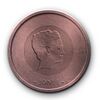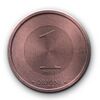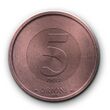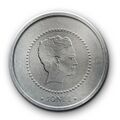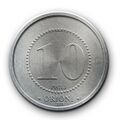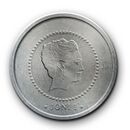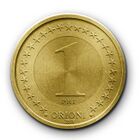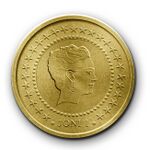Orinese Phi: Difference between revisions
m (→Coins) |
(→Characteristics: let's make some money) |
||
| Line 53: | Line 53: | ||
!rowspan="2"|Image ||rowspan="2"|Value ||rowspan="2" |∅ ||colspan="2"|Description | !rowspan="2"|Image ||rowspan="2"|Value ||rowspan="2" |∅ ||colspan="2"|Description | ||
|- | |- | ||
!Obverse | !Obverse!!Reverse | ||
|- | |- | ||
|align="center"|[[File:1 | |align="center"|[[File:ORP Copper Phili obverse (2018 issue).jpg|100px]] [[File:ORP 1 Phili reverse (2018 issue).jpg|100px]] | ||
|𝞅1 | |𝞅1 | ||
|20 mm | |20 mm | ||
|(Some kind of native flower) ||Denomination and year | |||
|- | |- | ||
|align="center"|[[File:5 | |align="center"|[[File:ORP Copper Phili obverse (2018 issue).jpg|110px]] [[File:ORP 5 Phili reverse (2018 issue).jpg|110px]] | ||
|𝞅5 | |𝞅5 | ||
|22 mm | |22 mm | ||
|Denomination | |Pink river dolphin ||Denomination and year | ||
|- | |- | ||
|align="center"|[[File:10 | |align="center"|[[File:ORP Silver Phili obverse (2018 issue).jpg|120px]] [[File:ORP 10 Phili reverse (2018 issue).jpg|120px]] | ||
|𝞅10 | |𝞅10 | ||
|24 mm | |24 mm | ||
|Denomination | |Mount Silesto ||Denomination and year | ||
|- | |- | ||
|align="center"|[[File:50 | |align="center"|[[File:ORP Silver Phili obverse (2018 issue).jpg|130px]] [[File:ORP 50 Phili reverse (2018 issue).jpg|130px]] | ||
|𝞅50 | |𝞅50 | ||
|26 mm | |26 mm | ||
|Denomination | |Orinese cedar tree ||Denomination and year | ||
|- | |- | ||
|align="center"|[[File:1 | |align="center"|[[File:ORP 1 Phi obverse (2018 issue).jpg|140px]] [[File:ORP 1 Phi reverse (2018 issue).jpg|140px]] | ||
|Φ1 | |Φ1 | ||
|28 mm | |28 mm | ||
|Effigy and monogram of Empress Joni I ||Denomination and year | |||
|- | |- | ||
|align="center"|[[File:5 | |align="center"|[[File:ORP 5 Phi obverse (2018 issue).jpg|150px]] [[File:ORP 5 Phi reverse (2018 issue).jpg|150px]] | ||
|Φ5 | |Φ5 | ||
|28 mm | |28 mm | ||
|Effigy and monogram of Empress Joni I ||Denomination and year | |||
|} | |} | ||
Revision as of 21:42, 22 February 2021
| Orinese Phi | |
|---|---|
| Fī Orīnīzi (Oharic) | |
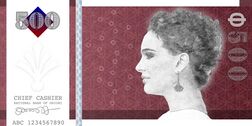 500 Phi banknote of the 2018 series | |
| ISO 4217 | |
| Code | ORP |
| Exponent | 2 |
| Denominations | |
| Subunit | |
| 1/100 | Phili |
| Plural | The language(s) of this currency do(es) not have a morphological plural distinction. |
| Symbol | Φ |
| Phili | 𝞅 |
| Banknotes | |
| Freq. used | Φ10, Φ50, Φ100, Φ500 |
| Rarely used | Φ1000 |
| Coins | |
| Freq. used | 𝞅1, 𝞅5, 𝞅10, 𝞅50 Φ1, Φ5 |
| Demographics | |
| Official user(s) | |
| Unofficial user(s) | |
| Issuance | |
| Central bank | National Bank of Orioni |
| Website | www.bank.gov.io |
| Printer | Royal Orinese Banknote Printing Corporation |
| Mint | Royal Orinese Mint |
The Orinese Phi, (Oharic: Fī Orīnīzi) is the official currency of Orioni as well as accepted tender in several countries on Eurth. The National Bank of Orioni is responsible for issuing notes and coins in the nation's currency. The currency was adopted in 1893 and is subdivided into 100 Phili. The Phi is the world's fifth-largest reserve currency.
Administration
The National Bank of Orioni dictates and oversees all monetary policy for the currency. The Royal Orinese Mint manages the minting of all coins. The Royal Orinese Banknote Printing Corporation manages the printing of all banknotes. This currency is the only acceptable legal tender for transactions within the country.
Characteristics
One Phi is subdivided into 100 Phili. Unlike other countries there are no denominations of 2, 20, 200 or 2000, etc. The Φ1000 bill is rarely used because it is often associated with crime and money laundering. Criminals who make a lot of money, especially drug dealers, prefer the large denomination: it is easier to transport Φ1000 notes compared to Φ50 or Φ100 notes.)
Coins
This article is incomplete because it is pending further input from participants, or it is a work-in-progress by one author. Please comment on this article's talk page to share your input, comments and questions. Note: To contribute to this article, you may need to seek help from the author(s) of this page. |
Compare with tables used on Wikipedia.
- https://en.wikipedia.org/wiki/Russian_ruble#Coins_2
- https://en.wikipedia.org/wiki/Euro_coins
- https://iiwiki.us/wiki/Montecaran_libra#Coins
- Reverse design in this style https://commons.wikimedia.org/wiki/File:1953_half_crown_obverse.jpg
Banknotes
History
The currency has only existed in its current form since 1893. The Orinese started using money in the 2nd century BCE. Medanese perfumes have been discovered as far away as Aroma, suggesting that the famous Pearl Road was already emerging. A currency was still a novel idea at the time. Previously it was shaped like dolphins, unique in shape, which seems inconvenient. It is interesting that the early Orinese adopted an ingot casting method in the dolphin shape, rather than the traditional round or square coinage of their contemporaries. This shape may also have carried religious significance.
(WIP. First currencies. Pre-decimal. Evolution. Establishment of modern currency. Use in the Empire.)
